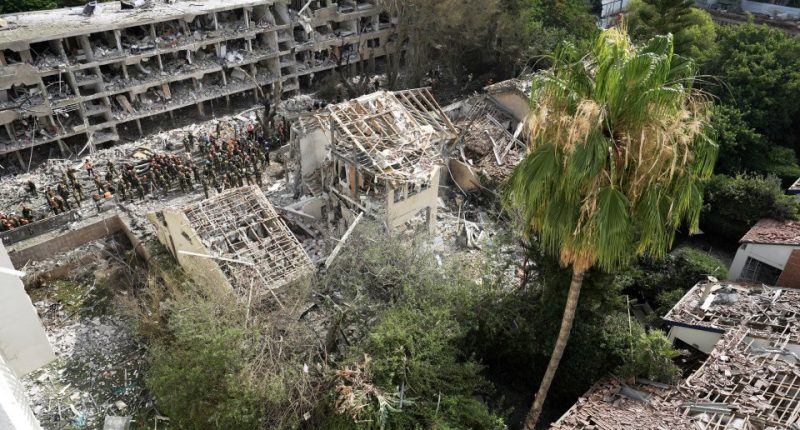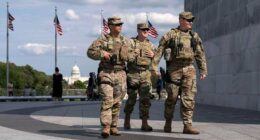Share this @internewscast.com
THE world is waiting with baited breath for Tehran’s response to Donald Trump’s strikes on three key nuclear facilities.
The conflict between Iran and Israel escalated to a global level when the United States deployed bombers and cruise missiles to destroy multiple sites in what was described as a “spectacular military success,” according to the US president.

After declaring the US strikes as being a success, Trump warned that further action could be taken if Tehran doesn’t agree to an adequate peace deal.
However, Iranian Foreign Minister Abbas Araghchi has cautioned that Tehran “reserves all options” for defending itself and declared that the attack “will have everlasting consequences”.
There is growing concern about Iran’s potential next move, with some experts suggesting possible retaliation could include the kidnapping of Americans, launching significant cyber-attacks, or disrupting oil supply.
US sites decimated
A simple response from Iran would be the decimation of US sites in the Middle East using its arsenal of ballistic missiles.
At least 50 Iranian missiles are thought to have struck down in Israel during the ten days of conflict.
But more than 450 have been intercepted by Israel’s sophisticated air defences, along with around 1,000 drones, according to the latest figures from the Israeli military.
Iranian preparations for missile strikes on US military bases in the Middle East have been exposed by American intelligence officers, anonymous officials told the New York Times.
There are over 20 bases across the region – the majority of which are within 2,000km range of Iran’s Sejil-2 ballistic missile.
US bases in Iraq and Syria would potentially be targeted first, according to The Telegraph.
American officials said that F-22, F-16 and F-35 fighter jets had been positioned in the Middle East – prime targets for Tehran missiles.
Major general Chip Chapman told The Sun how the bases represent key targets for Iran.
He said: “It could be that they do some sort of minimal strike on one or two bases, not a theatre-wide strike, which would involve Kuwait, Qatar, Saudi Arabia, all the American bases throughout the region.
“And we know from the UK perspective that the 20 plots, Iranian inspired plots against, Iranian dissidents.
“So you could see that against Israeli targets, a wide geographic region that’s that prolonged, sporadic, conflict.
“It is if you had that, that people would more overtly, I think, talk about regime change in general.”
Fears loom that Iran could even strike US embassies and consulates.
Several sources revealed to Sky News that the US embassy in Baghdad, Iraq, is likely to be attacked.
Sponsored terror attacks
Iran has not hid the fact it uses its network of regional proxies as defence.
Infamous Hezbollah and Hamas have been effectively keeping the Israeli military occupied – steering attention away from Iran.
And Yemen’s Houthis have also provided distraction to the West by relentlessly targeting commercial shipping in the Red Sea.
The group already vowed to target US ships if Washington launched an attack on Iran just hours before Trump’s nuke blitz – with the threat now potentially becoming a reality.
The Houthis had halted its attacks on US shipping containers after Trump boosted strikes on the group.
Crippling cyber attack
Iran and its regional proxies have claimed responsibility for various crippling cyber attacks on Israel.
Data has been destroyed and phishing campaigns launched in the past – meaning another cyber attack in response to the nuclear sites blitz could be on the cards.
The US government has desperately worked to gather information on Iranian hackers responsible for previous attacks due to the grave threats to defence.
An eye-watering $10 million reward was uploaded for details on a group known as CyberAv3ngers who US officials have tracked down to having links to the Islamic Revolutionary Guard Corps.
But experts have warned that Iran could struggle to actually launched large-scale cyber attacks when its regime is under extreme threat – like now.
Choking shipping lanes
Arguably Tehran’s most powerful weapon against the West is the Strait of Hormuz.
The narrow path of water between Oman and Iran is vital in the global supply of oil.
Major general Chapman told The Sun that the Islamic Republic could just shut down access to the Strait and cripple shipping through the area.
He said: “The worst case from the allies perspective, America and everyone else, is that the Iranians go towards a posture of closing the Strait of Hormuz.
“20 per cent of the world’s oil runs through that. And as of today, the price of a barrel of oil, Brant crude was $77.
“Now that is where the Brits may get involved, because one of the things about the British posture in the region and the opposition, it’s been a longstanding British, operation in the Persian Gulf and the wider Middle East is that we have mine countermeasure vessels, co-located with the American Fifth Fleet in Bahrain.
“If the Iranians were to try and close the Strait of Hormuz, that those would be a definite ask by the Americans to the Brits.
“The Iranian oil goes to China, it goes to India, places like that. They’re the ones who would suffer.”
Oil field blitzed
Iran has the potential to pull what’s been dubbed the “last big card” and launch an attack on vital energy infrastructure in the Gulf that powers the globe.
In 2019, two major Saudi Arabian oil plants, one in Abqaiq, Bugayg, and its second largest oilfield in Khurais, where engulfed in flames after a drone attack.
The Houthi rebels claimed responsibility for the attack – but the US and Saudi governments accused Iran of orchestrating it behind closed doors.
The Khurais oilfield was producing around one per cent of the world’s oil and Abqaiq is the largest facility and could produce seven per cent of the global supply.
This caused global energy prices to spike, and temporarily binned half of Saudi Arabia’s oil production.
Chaos unfolding
After declaring the US strikes as being a success, Trump warned that further action could be taken if Tehran doesn’t agree to an adequate peace deal.
He said in a nationally televised speech at the White House: “Iran, the bully of the Middle East, must now make peace. If they do not, future attacks will be far greater and a lot easier.”
“There will be either peace or there will be tragedy for Iran far greater than we have witnessed over the last eight days.”
“Remember there are many targets left. Tonight’s was the most difficult of them all, by far, and perhaps the most lethal.
“But if peace does not come quickly we will go after those other targets with precision, speed and skill.
“Most of them can be taken out in a matter of minutes. There’s no military in the world that could have done what we did tonight.”
And shortly after speaking on-camera, he posted to Truth Social: “This cannot continue. There will be either peace or there will be tragedy for Iran far greater than we have witnessed over the last eight days.
“Remember, there are many targets left. Tonight’s was the most difficult of them all, by far, and perhaps the most lethal.
“But if peace does not come quickly we will go after those other targets with precision, speed and skill.”
Meanwhile Iran’s foreign minister Abbas Arghchi dubbed the strikes “outrageous and will have everlasting consequences”.
He also called the military action “a grave violation of the UN Charter, international law and the NPT by attacking Iran’s peaceful nuclear installations”.
Arghchi added: “Each and every member of the UN must be alarmed over this extremely dangerous, lawless and criminal behavior.
“In accordance with the UN Charter and its provisions allowing a legitimate response in self-defense, Iran reserves all options to defend its sovereignty, interest, and people.”
A response from Iran, or from the Ayatollah in hiding, has not yet come.
Ali Khamenei is believed to be cowering away in a secret lair as Israeli missile attacks rain down nearby.
Two informed sources inside the country told Iran International the country’s ageing dictator is holed up in the bunker in Lavizan, a neighbourhood in Tehran.
Posting on Truth Social, President Donald Trump said US bombers targeted Fordow, Natanz, and Isfahan enrichment sites – all key to Iran’s doomsday project.
Analysis of the global implications

PHILIP Ingram, expert on international security
“Iranian ballistic missiles will not reach the United States and therefore to try and respond to the United States attack Iran’s going to have to do something different.
“It’ll bring its coalition of the willing that it has together or as we call them the axis of evil. So we’ve got Iran, Russia, North Korea and China.
“China will likely sit back and wait to see what’s happening, to begin with. But North Korea may provide Iran with some missile technology.
“Russia is sitting there laughing all the way to the bank effectively.
“The escalating conflict helps Russia by moving Russia-Ukraine further down the agenda so that people aren’t focusing on it.
“Iran and Russia will join forces to try and cause as much disruption in different countries as possible through protest and through disinformation.
“There will be two reactions directly out of Iran. One, the stimulation of their proxy organisations that they have operating across the world. Hamas and Hezbollah have been largely destroyed by Israel.
“But they’ve still got the Houthis in Yemen. I think we will see a massive uptake in Houthi activity in disrupting international shipping in the Red Sea.
“The other reaction could be trying to close the Straits of Hormuz. 30 percent of the world’s oil and gas goes through there.
“Even a threat to close it will put energy prices spiking to a level that will make the spike we saw when Russia invaded Ukraine seem like small change.”

























